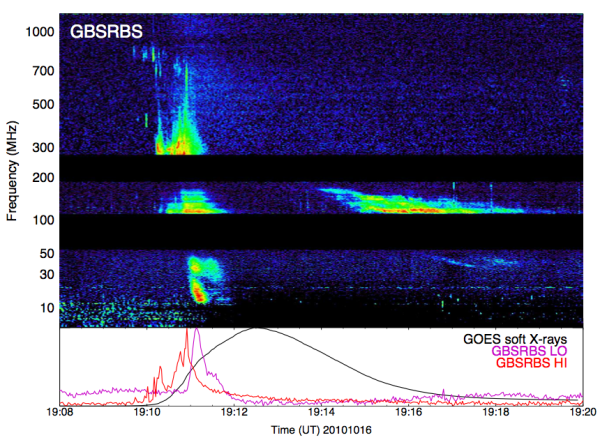M is for Magnifique Part Deux: Difference between revisions
Jump to navigation
Jump to search
imported>Schriste (Created page with "{{Infobox Nugget |name = Nugget |title = M is for Magnifique |number = 146 |first_author = Steven Christe |second_author = Andy Inglis |publish_date = 21 February 2011 |next_nugg...") |
imported>Schriste mNo edit summary |
||
| Line 11: | Line 11: | ||
== Introduction == | == Introduction == | ||
In this nugget, we would like to continue our analysis of the M class flare of October 16th 2010 (SOL2010-10-16T19:12) which we have previously discussed in a [M is for Magnifique|past nugget]. | In this nugget, we would like to continue our analysis of the M class flare of October 16th 2010 (SOL2010-10-16T19:12) which we have previously discussed in a [[M is for Magnifique|past nugget]]. | ||
== CMEs == | |||
Such a moving shock front might be indicative of a CME. | |||
[[File:2010oct16_GBSRBSradio.png|thumb|center|600px|'''Figure X''': The radio spectrum from GBSRBS showing associated type III and type II radio bursts. Type II radio bursts are signatures of traveling shock waves and are frequently associated with CMEs.]] | |||
== Conclusion == | == Conclusion == | ||
Revision as of 21:30, 8 February 2011
| Nugget | |
|---|---|
| Number: | 146 |
| 1st Author: | Steven Christe |
| 2nd Author: | Andy Inglis |
| Published: | 21 February 2011 |
| Next Nugget: | |
| Previous Nugget: | [At last, the EUV Spectrum] |
Introduction
In this nugget, we would like to continue our analysis of the M class flare of October 16th 2010 (SOL2010-10-16T19:12) which we have previously discussed in a past nugget.
CMEs
Such a moving shock front might be indicative of a CME.
